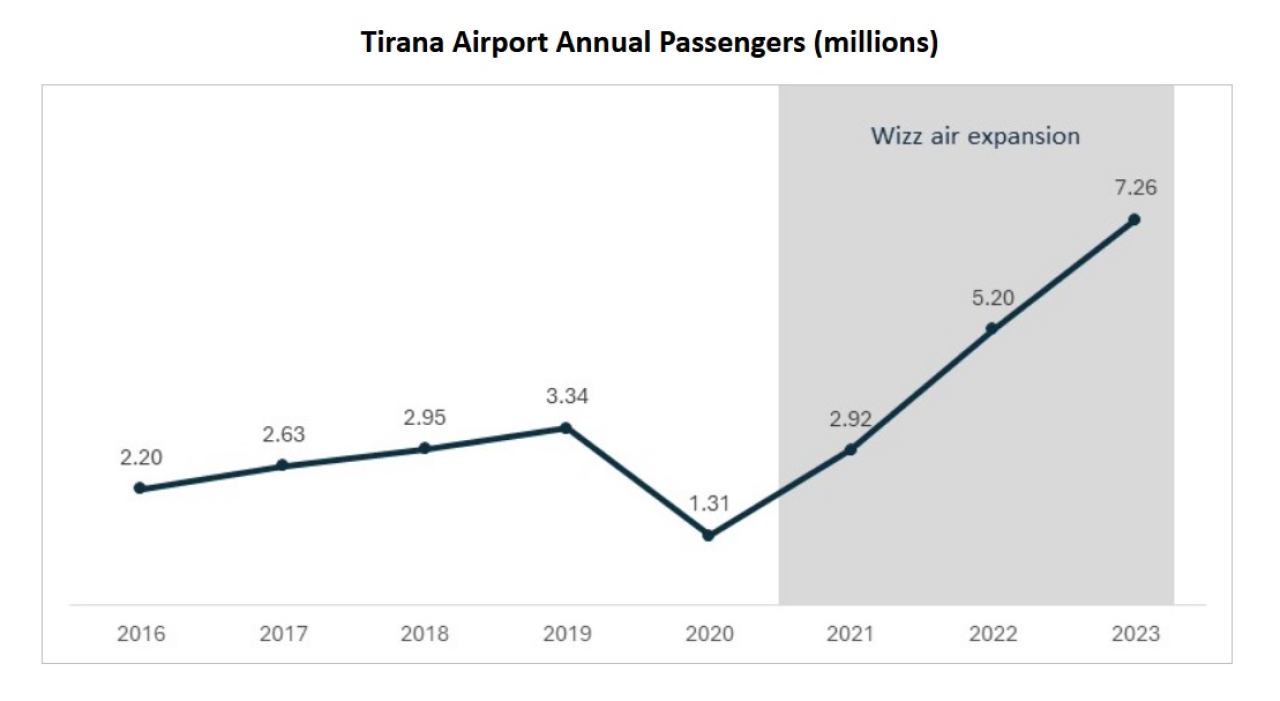Albania: A Case Study in the Power of Low-Cost Market Stimulation
Dion Zumbrink
April 17, 2024

Tirana's Skanderbeg Square.
© Chris Walts / Wikipedia
Air traffic development in Albania over the past years, especially post-pandemic, has been nothing less than impressive. The airport has doubled its annual throughput between 2019 and 2023 while coping with COVID19 in between.
The country left its borders open during the pandemic, attracting European tourism and Wizz Air deploying extra seat capacity at Tirana International Airport (TIA). The airline expanded its fleet continuously and identified open markets to release this capacity while other airlines downsized.

Incredible growth at TIA during and after the pandemic.
© Dion Zumbrink
Historically, there were hardly any low-cost carriers (LCCs) at TIA and only a small national airline, Air Albania. Italy has traditionally been the largest market, with Rome, Milan, Bergamo, and Bologna as the main destinations, mainly due to a large Albanian diaspora. Alitalia and Blue Panorama were the main operators in this market and had a combined market share of 51% at TIA back in 2016. Inbound tourism in Albania was minimal at the time.
Wizz Air saw the opportunity of an under-served market and opened a base in 2020 having had a small presence at the airport from 2017. In December 2020, Albanian conglomerate Kastrati Group took 100% ownership of TIA and established attractive incentive schemes to attract airlines, especially LCCs.
The combination of an attractive and lower-priced tourism destination, together with low airport fees has stimulated Wizz Air’s growth and boosted traffic demand. This is a clear example of how a large LCC can generate traffic flows that were non-existent or minor.
The chart below shows the traffic stimulation at the airport accomplished by Wizz Air, which now holds a market share of 61% (2023). While the total full-service traffic has remained relatively similar to 2016, Wizz Air managed to bring 4.4 million passengers to the airport in 2023, up from three million in 2022 versus an insignificant number pre-pandemic. The airline has established a major network to Italy, where it operates 17 routes, and throughout Europe.

Wizz Air dominates the market but Ryanair's recent arrival might change the balance.
© Dion Zumbrink
Ryanair came late to the party, starting operations at TIA in October 2023. The airline has an ambitious plan to go head-to-head with Wizz Air. In January, it released its summer 2024 schedule with 22 routes. Seven are to Italy and a large number directly overlap with rival Wizz Air.
By February, Ryanair had already obtained a 20% market share at the airport, with no signs of Wizz air backing down and retaining a 64% share. In 2024, traffic growth is therefore expected to continue growing. In the first two months of the year, the airport registered 1.2 million passengers, representing a staggering 59% rise compared to last year. The airport expects to end the year with nine million passengers, up from 7.3 million in fiscal 2023.
LCC market stimulation was therefore not yet reached with the Wizz Air network in 2023. Ryanair managed to add another level of passengers, proving the case that these airlines are capable of creating incremental business when opening their networks.
An example is the London route, traditionally served by British Airways. It grew from 97,000 annual passengers in 2017 to 582,000 in 2023 helped by Wizz Air's capacity from London Luton Airport attracting a completely new market segment of inbound tourists to Albania.
Most routes currently flown by Wizz Air were, however, non-existent before the pandemic. A number of examples below show the potential size when a low-cost carrier opens a completely new route.

New routes are as important as enhancing existing ones.
© Dion Zumbrink
In the case of Tirana, the arrival of Wizz Air and the current expansion of Ryanair signal how an airport can receive a boost of LCC traffic when the conditions are right.
Especially with inbound tourism potential, LCCs are capable of directing tourists from all over their network to a new location. Imperative to this development is the airport creating the right conditions for a low-cost carrier to flourish, something that Tirana has nailed.
